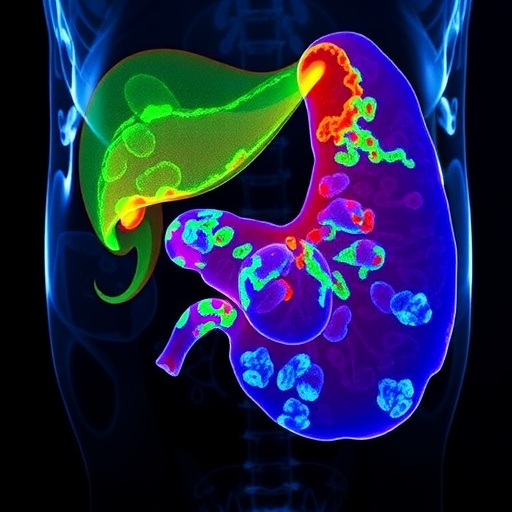Recent research has unveiled a groundbreaking discovery in the field of oncology, focusing on a novel small RNA molecule known as tRF-34-86J8WPMN1E8Y2Q. This molecule has been found to play a significant role in the initiation and progression of gastric cancer, one of the most prevalent and lethal forms of cancer worldwide. The study, conducted by researchers Cao, Xu, and Li, highlights the complex interactions between this tRNA-derived fragment and a protein named LRAT, which is implicated in the cancer’s malignancy.
As the study unfolds, it becomes clear that tRF-34-86J8WPMN1E8Y2Q acts as a crucial regulator in cellular processes that confer cancerous traits. The research illustrates how this small RNA, contrary to its previously underappreciated role, is integral in modulating various oncogenic pathways. By binding to LRAT, it appears to influence the aggressive nature of gastric cancer cells, providing new insights into how this disease develops at a molecular level.
Gastric cancer remains a major global health problem, particularly in regions such as East Asia. With its high mortality rate, understanding the underlying mechanisms that facilitate tumor growth is of paramount importance. The implications of this study are vast, suggesting that targeting tRF-34-86J8WPMN1E8Y2Q or its interaction with LRAT could open up new avenues for therapeutic interventions. This pioneering research paves the way for innovative strategies that could potentially disrupt the cancer developmental process.
The findings from this research provide a detailed look at the mechanisms by which tRF-34-86J8WPMN1E8Y2Q contributes to gastric cancer progression. The study employs advanced molecular biology techniques, which reveal that this tRNA fragment is not merely an byproduct of cellular metabolism but a vital player in regulating key oncogenic pathways.
As scientists explore the role of microRNAs and other small non-coding RNAs in cancer biology, tRFs have begun to emerge as significant players deserving of further investigation. The specific interaction between tRF-34-86J8WPMN1E8Y2Q and LRAT illustrates a new layer of complexity in the molecular dialogue occurring within cancer cells, shedding light on how cellular signaling can lead to malignancy.
In light of these revelations, the study raises intriguing questions about the potential for using tRFs as biomarkers for gastric cancer. Their presence could potentially serve as indicators of cancer progression or response to treatment. Clinical applications of these findings could lead to more personalized approaches in cancer therapy, where treatments are tailored based on the molecular profile of the tumor.
Throughout the study, researchers utilized various experimental designs including in vitro and in vivo models, providing robust evidence of tRF-34-86J8WPMN1E8Y2Q’s role in promoting gastric cancer. This approach strengthens the case for developing future therapies that explicitly target such RNA fragments, which could complement existing treatment regimens and enhance their effectiveness.
Future research will undoubtedly need to clarify the wider implications of targeting tRFs in cancer treatment. Understanding how these small yet impactful molecules interact with other cellular components will be essential in developing comprehensive treatment strategies for gastric cancer. Moreover, the potential for analogous findings in other cancer types may unveil a broader scope of applications within molecular oncology.
The authors emphasize the need for collaboration across various fields of study, including molecular genetics, pharmacology, and clinical oncology, to fully realize the potential of targeting RNA molecules in cancer therapy. By fostering multidisciplinary partnerships, significant strides can be made towards innovative cancer treatment methodologies.
As the scientific community absorbs the implications of this research, excitement builds around the prospect of novel therapeutic strategies that could emerge from targeting RNA interactions. The integration of bioinformatics and genomic technologies may streamline the identification of other RNA molecules with similar functional attributes, broadening the landscape of cancer research.
In summary, the discovery that tRF-34-86J8WPMN1E8Y2Q plays a critical role in the development of gastric cancer offers new hope for both researchers and patients alike. This small RNA fragment’s interactions with LRAT mark a significant milestone in our understanding of cancer biology, and it is anticipated that ongoing investigations will unravel even more intricate molecular pathways that drive tumor progression.
As future studies continue to expand our understanding of RNA biology, we may find new frontiers in cancer therapy, leading to more effective treatments and improved patient outcomes. The journey towards harnessing the therapeutic potential of small RNAs like tRF-34-86J8WPMN1E8Y2Q is just beginning, and the ramifications of this research could be felt for years to come.
The implications extend beyond just gastric cancer, as this study could pave the way for focusing on the interactions between non-coding RNAs and proteins in various cancer types. The vast potential for future discoveries leaves one optimistic about the relentless pursuit of knowledge within the realm of cancer research.
In conclusion, the study conducted by Cao, Xu, and Li serves as a cornerstone for understanding the underpinnings of gastric cancer through the lens of RNA biology. With each new finding, we draw closer to understanding how to outsmart this formidable disease and ultimately improve the lives of countless patients affected by it.
Subject of Research: The role of tRF-34-86J8WPMN1E8Y2Q in gastric cancer progression through interaction with LRAT.
Article Title: tRF-34-86J8WPMN1E8Y2Q promotes the occurrence and development of gastric cancer by combining with LRAT.
Article References:
Cao, C., Xu, S. & Li, Z. tRF-34-86J8WPMN1E8Y2Q promotes the occurrence and development of gastric cancer by combining with LRAT. J Cancer Res Clin Oncol 151, 276 (2025). https://doi.org/10.1007/s00432-025-06332-5
Image Credits: AI Generated
DOI: 10.1007/s00432-025-06332-5
Keywords: gastric cancer, tRF-34-86J8WPMN1E8Y2Q, LRAT, small RNA, molecular oncology, cancer therapy, biomarkers, RNA interactions.
Tags: Cancer Treatment StrategiesEast Asia gastric cancer prevalencegastric cancer global health issuesgastric cancer progression mechanismsLRAT protein interactionsmolecular mechanisms of tumor growthnovel cancer biomarkersoncogenic pathways regulationsmall RNA molecules oncologytargeting small RNA in cancer therapytRF-34-86J8WPMN1E8Y2Q gastric cancer researchtRNA-derived fragments in cancer





